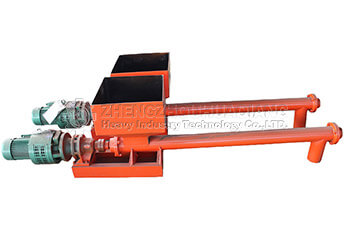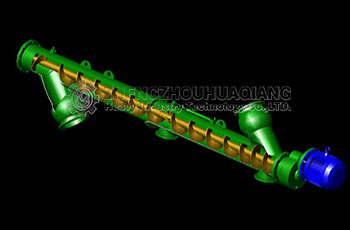Screw conveyor is a widely used conveying equipment in metallurgy, coal mine, chemical industry, etc. It is suitable for conveying powder, granular and small bulk materials horizontally or obliquely, especially powder or solid particles with higher temperature or suitable for sealed conveying. These are common faults of some screw conveyors and should be avoided when using them.
Common faults of screw conveyor
1. Axis blockage of helical blades leading to shutdown
a) When too much material is injected into the screw conveyor, the maximum pressure that the screw blade shaft can bear is not considered, which increases the load of the motor and finally stops the machine.
b) When the seal of the bearing is damaged, it will lead to the reduction of the seal at the bearing. In the process of operation, the material can easily enter the bearing and damage the bearing.
c) When the material is added, some large particles of material are mixed, which increases the resistance of operation, leads to overload and blockage of the motor, and makes the thermal protection device of the motor work, leading to shutdown.
2. Abnormal bearing of reducer
a) Generally, the main cause of bearing failure of reducer is the lack of oil in the reducer box caused by inadequate maintenance, resulting in serious wear and tear of gears and bearings, leading to the main shaft offset.
b) In the process of maintenance, more lubricants lead to the heating of bearings, the temperature rise of the box often occurs, and the stability of the bearing seat can also affect the operation performance of bearings.
c) When the temperature of the input shaft is abnormal, the temperature of the output shaft does not change. It may be due to the loosening of the bolt of the fixed motor or the failure of the bearing of the output shaft.
d) The temperature of the output bearing and the input bearing of the reducer rises simultaneously, mainly because the bearings at both ends of the reducer are damaged at the same time, or the fixed bolts of the reducer are loosened.
3. Screw breakage of screw conveyor
Screw breakage is a common fault of screw conveyor. Because of the lack of support and positioning of the central rod in its structure, the screw angle will bear the force of two directions at the same time if it meets greater resistance in the operation process. One is the force from the axis, and the other is the vertical force from the material. Under different forces, the spiral angle will produce different deformation effects. When the material with uniform texture is added to the conveyor, the deformations mentioned above will not occur due to the uniform force on the helical blade, and the service performance of the mandrel will not be affected. If in order to eliminate the fault repeated forward, reverse, it will lead to the spiral blade repeated large impact force, the screw is easy to break.
4 Other faults
a) Gear transmission produces abnormal noise. The main reason may be the loosening of transmission device and support of gears, which affects the spacing of transmission gears. Or the offset and loosening of bearings at both ends affect the spacing of transmission gears.
b) The flange weld joints form torsional cracks. The main reason is that in the course of operation, it is disturbed by other direction forces, resulting in abnormal torque and cracking of connecting flange under the influence of various forces.
c) Cracks occur in the coupling shaft. The main reason is that some wear occurs during long-term operation, and cracks occur when wear reaches a certain degree.

